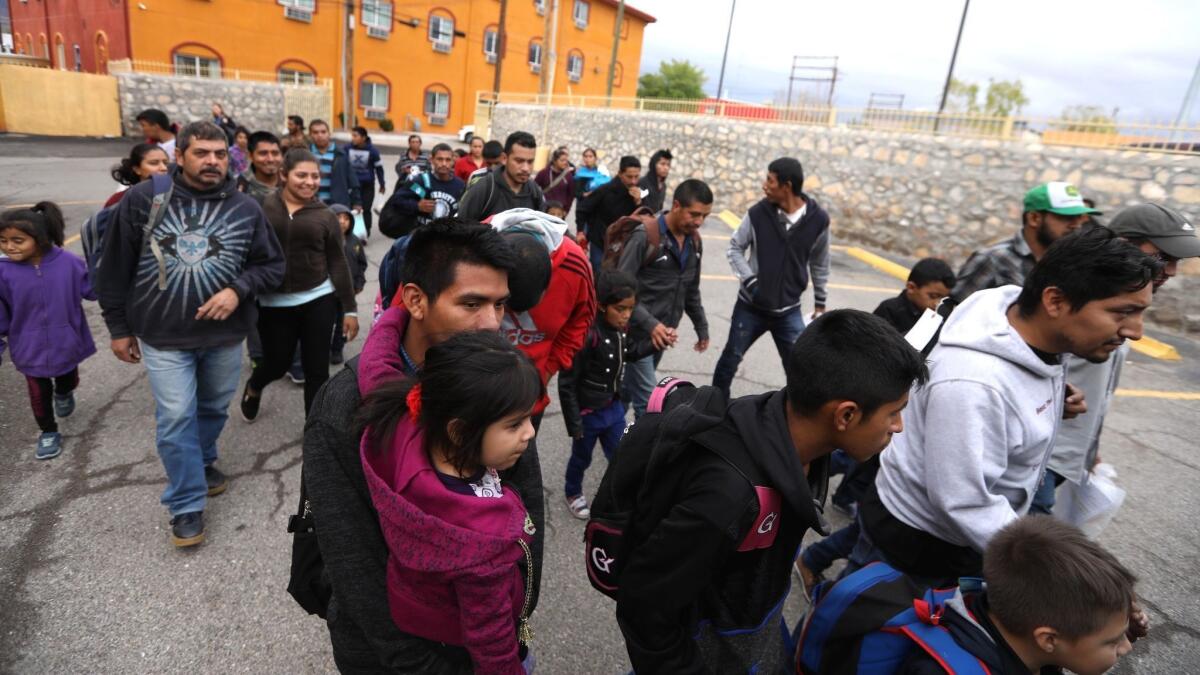Can Trump stop asylum seekers?

Reporting from Houston — President Trump is poised to issue an executive order next week aimed at stopping a caravan of thousands of Central American migrants crossing Mexico toward the United States, many with plans to claim asylum.
In a speech Thursday, Trump provided few specifics about the order but vowed to prevent applicants who are “coached” by attorneys from remaining in the United States while their “fraudulent or meritless asylum claims” are processed.
But that is likely to prove difficult. Here is some background on the asylum process and the obstacles Trump faces.
How do migrants qualify for asylum?
Under federal law, immigrants can claim asylum based on a “credible fear” of persecution or harm on account of race, religion, nationality, political opinion or membership in a “particular social group.”
For each migrant seeking asylum at a border crossing, an asylum officer conducts a credible fear screening interview. Based on that interview, the officer decides whether the applicant has a “significant possibility” of being eligible for asylum. A rejection results in a removal order, though the applicant may appeal to an immigration judge.
Those who pass are referred to immigration court and either released — sometimes with “alternatives to detention,” such as ankle monitors and reporting requirements — or transferred to an Immigration and Customs Enforcement detention facility to await a hearing.
How much leeway does the Trump administration have to change the qualifications?
The rules to some extent are open to interpretation.
Last summer, the Trump administration decided that victims of gang and political violence would no longer be considered “particular social groups,” and this June, U.S. Atty. Gen. Jeff Sessions took the unusual step of intervening in a case involving a Salvadoran immigrant — identified as “A.B.” — who left her three children behind to flee attacks and death threats by her ex-husband and his brother, a police officer.
An asylum officer initially found the woman had a credible fear of returning to El Salvador. But Sessions issued a decision that, “generally, claims by aliens pertaining to domestic violence or gang violence perpetrated by non-governmental actors will not qualify for asylum.”
“The asylum statute does not provide redress for all misfortune,” he wrote.
The administration then instructed asylum officers to apply Sessions’ decision to the “credible fear” process at the border. Civil rights groups filed suit, claiming the new rules violate a series of federal laws and constitutional principles.
With that case pending, it has been left to judges in the country’s 59 immigration courts to interpret Sessions’ ruling.
Newly appointed judges have been more likely to reject asylum claims by victims of domestic or gang violence, while more seasoned judges have been more likely to grant them, according to Lindsay Harris, co-director of the American Immigration Lawyers Assn. asylum and refugee committee.
“It’s really not consistent,” Harris said.
Trump said that most asylum seekers never show up for their court dates and remain in the country illegally. Is that true?
No. Between 60% and 75% of immigrants who were not being detained by the government attended their immigration court proceedings, according to statistics from the Justice Department.
Harris cited a recent study by the American Immigration Council that found 96% of families seeking asylum attended their court hearings.
Other studies show the percentage of asylum seekers who attend court increases even further when they have attorneys, which are not provided in immigration court.
Mark Krikorian, executive director of the Center for Immigration Studies, which supports restricting immigration, agreed that Trump’s was “exaggerating” the figures.
Still, nearly 140,000 non-detained immigrants were ordered deported from 2012 to 2016 because they failed to appear in court, according to the Justice Department.
“They only use credible fear as a way to get past Border Patrol and get dropped off at the bus station,” Krikorian said.
How often are asylum claims granted?
During the first half of this year, about 15% of asylum seekers who went to court had their claims granted, according to the Transactional Records Access Clearinghouse, a research group at Syracuse University.
That was about half the rate during the second half of 2017.
The rates also varied widely between immigration courts. In San Francisco, for example, it was 39% over the last three years. In Los Angeles, it was 20%. And in Atlanta, it was 1%.
Asylum seekers with attorneys fare much better. Over the last six years, Hondurans with attorneys were granted asylum about 30% of the time. Those without attorneys got asylum 5% of the time.
Either way, the process can take a long time due to a backlog of cases. People who succeed in immigration court — including asylum seekers — wait an average of 1,000 days. California and New Jersey had the longest average wait: 1,300 days.
Trump administration officials have suggested that Central American migrants wishing to claim asylum should do it in Mexico before they reach the United States. Can the U.S. government require that?
Mexican leaders would have to agree to become a “safe third country” for the asylum seekers. Only Canada has such an agreement with the United States.
Mexico’s president-elect, Andres Manuel Lopez Obrador, who is set to take office Dec. 1, does not appear amenable to absorbing thousands of Central American asylum seekers.
“We are not going to do that,” Alejandro Encinas, the incoming deputy interior minister for human rights, said at a press conference this week in Mexico City.
Can the United States stop asylum seekers at the border?
The law says anybody arriving at the U.S. border has the right to claim asylum.
U.S. Customs and Border Protection, however, employs tactics that drive away some migrants. It has stationed officers at the midpoint or “limit line” of border bridges to stop asylum seekers before they reach the United States. And in California, immigrants must add their names to a list and wait — often for weeks — to enter, a process called “metering.”
Commissioner Kevin McAleenan said last week that the agency was using metering in response to an influx of immigrants that strained border processing areas and that metering could be expanded to other border crossings if the number of arrivals continues to increase.
Immigrant advocates in California sued the administration in federal court last year, arguing that the agency is illegally turning away asylum seekers. That case is pending, and asylum seekers were still being forced to wait at border bridges this week.
Trump said he wants to end asylum for immigrants who cross illegally between ports of entry. Is that legal?
Probably not.
Under the 1951 U.N. Convention Relating to the Status of Refugees — which was adopted into U.S. law — the United States must recognize those who fear persecution and are unable to get help from their country.
“The U.N. Treaty we signed says people who are illegally in your country for that reason alone can’t be denied asylum,” Krikorian said. “Whatever they do, they’re going to end up in litigation. Congress needs to make some of these changes, the loopholes the president talks about.”
Harris said Trump’s proposal would violate section 208 of the Immigration and Nationality Act.
Trump said he wants to detain asylum seekers in temporary “tent cities” while their cases proceed instead of releasing them. Can he do that?
Probably not, especially when it comes to immigrant families with children.
“I don’t see how they can make basic changes without Congress,” Krikorian said.
The Trump administration is drafting new regulations aimed at allowing indefinite detention of immigrants. But a 1997 federal court ruling in the landmark Flores case limits detention of immigrant children to 20 days. Krikorian said it might be possible to extend detention of families with children if the parents agreed.
Harris said detaining families indefinitely “basically guts Flores.”
“I think they’re hoping people will abandon their claims,” she said. “But that’s not what you’re going to see when people are fleeing for their lives.”
Twitter: @mollyhf
More to Read
Sign up for Essential California
The most important California stories and recommendations in your inbox every morning.
You may occasionally receive promotional content from the Los Angeles Times.











